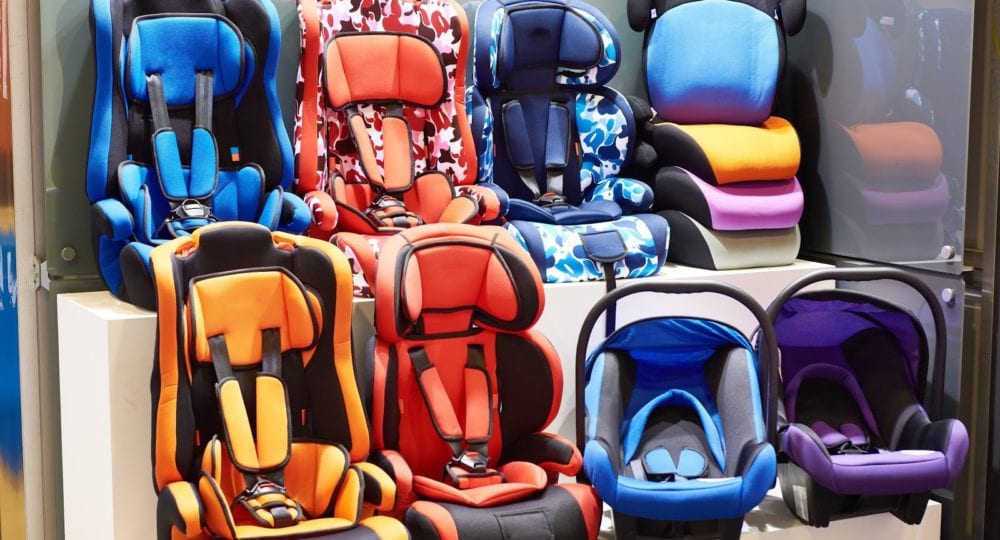In 2016, 723 children, 12 years old and younger, died in a motor vehicle accident (MVA), and more than 128,000 were injured in the U.S. Motor vehicle accidents are a leading cause of death among children in the US, but many of these deaths can be prevented.
Of the 723 children that died in an MVA in 2016, 35% were not buckled up at all. Child restraint systems are also often used incorrectly. About half of car and booster seats are misused in a way that could reduce their effectiveness.
So, what can you do to keep your most precious cargo safe? Start by ensuring your child has an appropriate car seat. Car seats should be selected based on the child’s age and size. The National Highway Traffic Safety Administration (NHTSA) has a helpful tool on their website here where you can enter your child’s information and get specific recommendations. Listed below are some general recommendations by age group.
Infants and toddlers
- Ride rear-facing as long as the car seat allows. Most convertible seats have limits that will allow children to ride rear-facing for 2 years or more.
- The harness chest clip should be positioned in the center of the chest and even with the child’s armpits.
- A toddler’s feet touching the back of the vehicle seat is still safe. Children can bend their legs easily and still be comfortable.
Toddlers and preschoolers
- Once they have outgrown the rear-facing height or weight limit for their convertible seat, they should use a forward-facing seat with a harness for as long as possible, up to the highest height or weight limit allowed by the car seat manufacturer.
- Many seats can accommodate children up to 65 pounds or more.
School-aged children
- Only after they have outgrown the height or weight limit of their forward-facing seat with harness, they should use a belt-positioning booster seat.
- When used appropriately, the lap belt should lie low and snug across the child’s upper thighs. The shoulder belt should cross the middle of the child’s chest and shoulder and should be off of the neck.
Older children
- When children are old enough and large enough for the vehicle seat belt to fit them correctly, they should always use lap and shoulder seat belts for the best protection.
- All children younger than 13 years should ride in the back seat. Airbags in the front seat can kill or seriously injure young children.
In August 2018, the American Academy of Pediatrics (AAP) updated their recommendations on car safety seats to include keeping children in a rear-facing seat as long as possible, until they reach the highest height or weight limit of their seat.
This should not be limited by age, and most can remain rear-facing past their second birthday. According to the AAP: “When a child rides rear-facing, the head, neck, and spine are all supported by the hard shell of the car safety seat, allowing the car seat to absorb most of the crash forces, and protecting the most vulnerable parts of the body. When children ride forward-facing, their bodies are restrained by the harness straps, but their heads – which for toddlers are disproportionately large and heavy – are thrown forward, possibly resulting in spine and head injuries.”
Here are some other ways to make sure you keep your child as safe as possible on the road:
- Bulky clothing, like winter coats and snowsuits, can limit the effectiveness of a car seat and should be removed prior to buckling up.
- Buckle children in the middle of the back seat when possible because it is the safest spot in the vehicle.
- Avoid used a car seat if you don’t know the seat’s history.
- Never use a seat that has been in a moderate or severe crash (as defined here).
- Check the label for the expiration date. If only the date the seat was made is listed, check with the manufacturer to find out how long it recommends using the seat.
- Register the seat to stay up-to-date on recall information.
- Ensure proper installation of the seat. Certified car seat technicians are available to help install and inspect car seats. You can find one here.
Car seat use reduces the risk of injury in a crash by 71-82% for children when compared to seat belt use alone.
Booster seat use reduces the risk for serious injury by 45% for children 4-8 years when compared with seat belt use alone.
For older children and adults, seat belt use reduces the risk of death and serious injury by approximately half. Help keep your child safe in the car by using the right car seat in the right way!
More information and resources about car seat safety, as well as the content discussed in this article can be found below.





